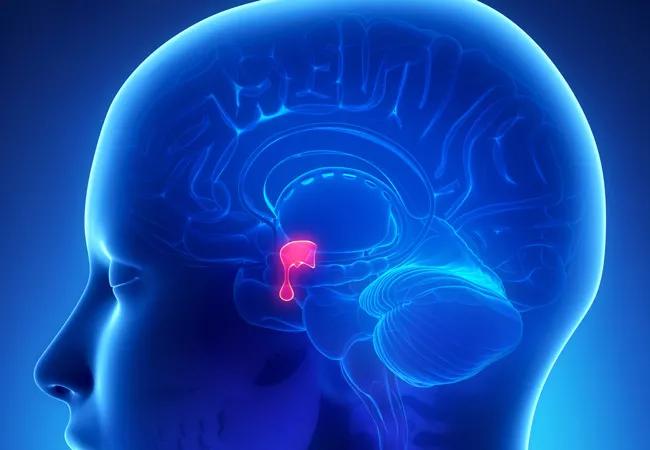An update from Laurence Kennedy, MD, FRCP

Acromegaly is a rare disorder characterized by excessive production of growth hormone (GH) by the pituitary gland that results in abnormal growth of the bones and soft tissues, most often those of the head, hands and feet. The term “acromegaly” was coined from the Greek words acro (“extremities”) and megaly (“great”).
Advertisement
Cleveland Clinic is a non-profit academic medical center. Advertising on our site helps support our mission. We do not endorse non-Cleveland Clinic products or services. Policy
Acromegaly is most often caused by a benign tumor (adenoma) of the pituitary gland. The disease predominantly affects the middle-aged population and is approximately equally common in men and women.
“The incidence of acromegaly in the medical literature varies from five to six new cases per million to as many as 20 new cases per million, so it is not particularly common. However, for clinicians treating pituitary disease, it is one of the most common pituitary conditions associated with overproduction of a hormone, in this case GH,” says Laurence (Ned) Kennedy, MD, FRCP, Chairman of Cleveland Clinic’s Endocrinology, Diabetes, and Metabolism Department.
According to Dr. Kennedy, if suspected, acromegaly is not difficult to diagnose.
“It is invariably associated with elevated levels of insulin-like growth factor-1 (IGF-1), which is a good indicator of GH activity,” he says. “However, clinicians often do not think of this diagnosis because the typical symptoms are long-standing and extremely slow to develop.”
Dr. Kennedy further explains that the changes associated with the condition, such as enlargement of hands and feet, are often so gradual that people experiencing them do not consider them serious.
“Patients and physicians should look for subtle changes in bone and soft tissues: the lips getting larger, the jaw becoming more elongated, the hands getting broader, or the forehead becoming more prominent,” says Dr. Kennedy. “Another potential symptom is profuse sweating and, occasionally, headaches. The adenoma can also press on the optic apparatus and start to interfere with vision. Acromegaly may also be suspected in patients who complain of snoring and sleep apnea.”
Advertisement
According to Dr. Kennedy, surgery is the preferred treatment option for acromegaly, because it can successfully put the disease in remission. The skill level of the surgeon performing the operation is an important consideration.
“The operation should be done by an experienced pituitary or skull base surgeon,” he says.
Dr. Kennedy says that it is important to obtain intermittent MRIs of the pituitary gland after surgery to monitor for presence of any remaining adenomatous tissue, because GH-secreting tumors can be invasive and cause injury to the surrounding tissues.
“In cases where surgery does not result in remission, drugs which decrease the production of GH, or block its action, may be used,” he adds. “These medications may be used as monotherapy or in combination. Another option is radiotherapy applied to the pituitary gland.”
“Invasive adenomas of the pituitary can spread into the cavernous sinuses right beside the gland which makes them much more difficult to operate on and more dangerous,” explains Dr. Kennedy. “Thus, in most cases, radiation treatment is also considered.”
However, although radiotherapy may be effective in limiting the growth of an invasive adenoma, Dr. Kennedy says medical treatment is more rapid in lowering GH or blocking its effect.
“In acromegaly, the levels of IGF-1, a growth factor produced in the liver, are elevated and one of the goals of treatment is to get IGF-1 in the normal range,” he says. “Medications used most often are somatostatin analogs, such as octreotide and lanreotide. Both drugs are approximately equally effective in lowering IGF-1 levels. Another option is pegvisomant—a GH receptor antagonist—which acts by occupying the GH receptor and preventing GH from acting, thereby decreasing IGH-1 levels.”
Advertisement
According to Dr. Kennedy, combinations of drugs with different mechanisms of action are also sometimes used to treat acromegaly.
“Cabergoline, a dopamine agonist may be prescribed in cases when IGF-1 levels remain mildly or moderately elevated after surgery. Sometimes, cabergoline and either somatostatin analogue or pegvisomant can be given in combination,” he says.
Dr. Kennedy believes that presenting patients with the various treatment options, and their modes of delivery, is the best approach to deciding on the optimal treatment course.
“Somatostatin analogs are given by deeper injection every 4 weeks, pegvisomant is given by subcutaneous injection daily, long-acting octreotide is an intramuscular injection, and lanreotide is given by deep subcutaneous injection. Cabergoline is given by pill,” he says. “Once the patients understand all the available treatment options, I can help them decide which one is the best for them.”
Advertisement
Advertisement

Advocacy group underscores need for multidisciplinary expertise

A reconcilable divorce

A review of the latest evidence about purported side effects

High-volume surgery center can make a difference

Advancements in equipment and technology drive the use of HCL therapy for pregnant women with T1D

Patients spent less time in the hospital and no tumors were missed

A new study shows that an AI-enabled bundled system of sensors and coaching reduced A1C with fewer medications

Association revises criteria for the diagnosis and resolution of severe conditions